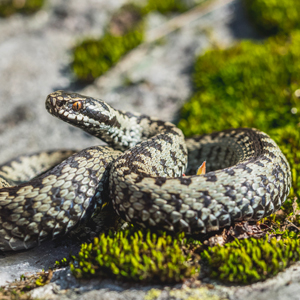ABOUT ADDER BITES
- Adder bites are fairly rare. Snakes generally only bite in self-defence, so normally bites occur when a snake is stepped on or disturbed by your dog. Puppies and young dogs can be especially curious and can unintentionally provoke an adder into biting.
- Most adder bites occur between April and July
- Common adder habitats are sand dunes, rocky hillsides, moorland and also woodland edges
- If your dog is bitten, don’t panic, try to keep them still and seek veterinary attention straight away
- The most common signs are significant pain and swelling where the bite occurred as well as depression and lethargy
- Less than 5% of patients display more severe signs and complications 96-97% of bitten dogs make a full recovery, usually within 5 days, with appropriate treatment
WHAT TO LOOK OUT FOR
- Adder bites can result in swelling around the wound, usually within 2 hours.
- You might be able to see the 2 puncture wounds in the centre of the swelling.
- Other than swelling your dog may show signs of pain, bleeding, bruising, lameness and may appear nervous. If the adder venom is absorbed into the rest of the body it can cause a widespread inflammatory reaction leading to symptoms such as lethargy, fever, increased heart and respiratory rates, drooling, vomiting and a wobbly gait. In severe cases animals may collapse, have blood clotting problems, organ failure, tremors or convulsions.
- Bites most commonly occur on a dog’s legs or face. If your dog is bitten on the face, it could lead to swelling of the face and muzzle and may result in breathing difficulties.
WHAT TO DO IF YOU SUSPCT YOUR DOG HAS BEEN BITTEN
- First of all, seek veterinary attention. It’s important to remember not to panic; your dog is highly likely to fully recover if treatment is given promptly. For a full list of local and emergency vets click here.
- Carry your dog (rather than allow him or her to walk) to try and reduce the spread of venom around the body. Bathe the wound in cold water to help control the swelling and try to keep your dog quiet and warm as you travel to your nearest vet practice.
- As with any emergency, it is a good idea to ring your vet in advance to let them know what has happened and your estimated time of arrival. This means the practice can make sure they have a vet available to see you and it gives them time to prepare any treatments.
- If you’re unaware your dog has been bitten but you notice anything which may be suggestive of a bite later on, it’s important that you ring your vet without delay, even if it is outside of normal opening hours.
WHAT NOT TO DO
Piriton: Antihistamines are used when a natural histamine reaction occurs like with an anaphylactic case. Venom is a toxin (poison) which needs symptomatic treatment and sometimes anti-venom. There have been no studies to prove the use of histamines with adder bites. There can be a slight histamine release along with other hormones as a reaction to the bite so it has been used in many cases but getting the correct dose is paramount. You can actually overdose on antihistamine so seeking veterinary advice is very important.
Tourniquet: Never apply a tourniquet. This can lead to infection and restrict circulation.
Suck venom out: Do not attempt to suck the venom out of any puncture wounds. Venom spreads quickly and efficiently through the lymphatic system. It is almost impossible to suck hard enough to pull an adequate amount of venom out to make a difference.
ABOUT ADDERS
The only venomous snake native to the UK is the European adder (Vipera berus). Adults are roughly 50-60cm long and have a black/brown zigzag pattern along their back and V or X shaped marking on the back of the head. They are most commonly found in the south and south west of England, western Wales and Scotland where their preferred habitats are sand dunes, rocky hillsides, moorland and woodland edges.
Adders are protected by the Wildlife and Countryside Act 1981; this means that it is an offence to kill, harm, injure, sell or trade them.
Information taken from https://www.companioncare.co.uk
